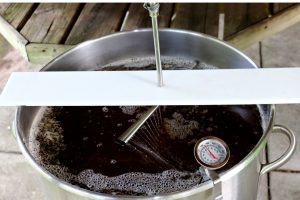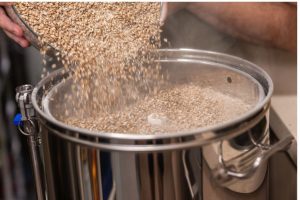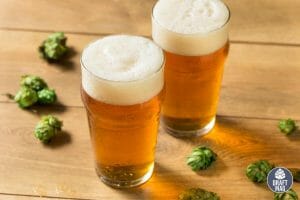Batch Sparge Vs Fly Sparge: Which One Should I Choose?

Batch sparge vs fly sparge is an ongoing debate among avid beer enthusiasts. Beer is a drink you can’t possibly say no to. It has been a go-to celebratory drink for ages.
The good news is, we are no longer at the mercy of industrialists to brew for us. Homebrewing has become quite a trend in the past few decades. The availability of home brewing kits has made the process simpler.
However, brewing beer is an art, and you are always just one step away from a ruined batch. One of the key steps in the process is sparging. In this article, we will explore the most common sparging techniques and some considerations to make when choosing the right one.
What Is Sparging?
Sparging is the practice of sprinkling or pouring 170 °F water across mash to collect or rinse away any remaining sugars. It is done after the initial mash to remove as much sugar from the grain bed as possible for the most effective mash.
Put in simple words, it is the process of extracting sugar from the grain bed into the boil kettle. However, one must be wary of unwanted tannin extraction.
While there are three distinct methods for sparging, they all involve running brewed water over your mash pile until all of the sugar has been recovered. The sparging process alters the flavor of the wort and is not appropriate for all types of beer. Simply said, the “best” technique to sparge is the one that allows you to get the taste profile you desire in your homebrew.
To decrease tannin extraction while still efficiently washing the grains, keep the sparge water temperatures between 165-170 °F (74-77 °C) for both batches sparing and fly sparging. Let us have a look at the two most popular sparging techniques.
What Is Fly Sparge?

Most commercial breweries and all-grain homebrewers employ fly sparging, also known as continuous sparging. Commercial brewers use fly sparge because of its efficiency over other sparge processes.
Fly sparge involves the continuous sprinkling of sparge water over the grain mash while in the boil kettle. The main aim is to extract sugar for the yeast to feed on. For maximum extraction, avoid water channeling and make sure it is evenly spread on the mash bag.
Here is where a fly sparging arm comes into the picture. It allows sprinkling water over the grains without channelizing.
You may also simulate the fly sparging by running the sparge water through a strainer or screen over the mash. Though the fly sparge method is a quick and easy way to sparge your grains, a real fly sparge needs sparge equipment, time, and work. It allows separating a thicker, sweeter wort from a thinner, less sweet solution.
Things To Keep In Mind
There are a few things you must bear in mind before you choose to fly sparge. Read ahead to find out these important details!
– The Flow
It is vital to regulate the flow of water. Ideally, the flow should be the same rate as the wort is being lautered in the boil kettle. You must re-assess the wort and stop the sparge when enough of it has been collected. This process requires your undivided attention.
– The Temperature
Temperature also plays an essential role in the sparging process. 170 °F is considered to be an ideal temperature. Higher temperatures can lead to the absorption of tannins, as they become more soluble at higher temperatures.
– Depth of the Grain Bed
You wouldn’t want your grains to come out all murky. Thus, ensure that the grain bed is not too shallow. On the other hand, there is a risk of stuck sparge if the bed is too thick. Thus, you need to strike a perfect balance between the two.
Why Should I Use Fly Sparge?
Here are a few good reasons to use fly sparge.
Fly sparge offers higher efficiency than the batch sparge method. Hence, competitive commercial brewers often opt for fly sparging. Passionate homebrewers who want their beer to be perfect also choose this method.
However, it is expensive as it requires the use of intricate equipment. Thus, if you view brewing as a hobby, this might not be the most economical option.
Fly sparging is also the most effective technique to extract as much sugar from your grain as possible. This is why sparge is used by nearly all professional brewers.
In other words, it is an excellent technique to maximize the value of your grain. It also allows for effective sugar extraction (both fermentable and non-fermentable).
It is cost-effective since it reduces the input (grain) into the process. Also, with batch sparging, you must watch the outflow, add extra water, and stir. Fly sparging, on the other hand, does not need as much care.
What Is Batch Sparge?

Taking hot water and putting it into a drained mash tun is known as batch sparging. Here you empty the mash tun into your wort after waiting a few minutes for the grain to settle. The brewer repeats this process several times, each time producing a separate “batch.”
This method varies from the English approach in that the mash is not kept at the saccharification temperature for an extended period before draining. This is where a brew-in-a-bag comes in handy. This technique of all-grain brewing includes mashing the grains in your brew kettle and holding them in a big fine-mesh bag.
This mash is referred to as a “full-volume mash” since it incorporates the whole boil volume. Batch sparging is significantly faster than fly sparging and can frequently be tooled more simply. Hence, many homebrewers prefer it.
Things To Keep In Mind
Here are a few things to consider before you try batch sparging.
– The Temperature
Any temperature below 145 °F (62.8 °C) causes grains to gelatinize, sealing up your grain bed. Keep your mash tun protected with a thick blanket or insulating mats to avoid this.
Before pouring, heat your sparge water to about 185 °F (85 °C) to retain your grain bed at mash-out temperature, ensuring that your wort flows smoothly and steadily.
– Slow Down With Your Lauter
When you are ready to lauter, start gently since excessive rates of wort flow might suck too much liquid from your grain bed, causing a “vacuum lock” that prevents any flow.
Begin with a slow flow and gradually increase the flow to ensure you receive all of the wort you need to brew your beer properly.
– Ensure Well-Crushed Grains
Over-crushed malts can result in a powdery foundation with too much flour and not enough grist, which mashes into the glue. Consider putting some water in that “instant snow” powder. Under-crushed malts can reduce batch sparge efficiency by preventing the release of sugars that will ferment into alcohol. Crushed grain kernels but unbroken husks appear from perfect milling.
Why Should I Use Batch Sparging?
Here are a few reasons why you should Batch sparging.
Batch sparging techniques may save 30-45 minutes off your brew time since you’re not waiting for all of that sparge water to drain in and out of your mash tun.
It is also cost-effective since it does not require any new equipment.
The likelihood of tannin extraction due to the pH of the grain bed decreasing toward the end of the sparge can pose a risk for your homebrew. However, with batch sparging, you don’t have to worry too much since the pH in this technique is consistent and never falls to the point that triggers tannin extraction.
Fly Sparge Vs Batch Sparge: Which One To Choose
Both sparge processes have advantages and disadvantages, and either can work well in a homebrewing system.
|
Batch sparging |
Fly sparging |
| Batch sparging is faster, but it comes at a higher cost in terms of efficiency. | Fly sparging may be the best option for homebrewers looking to save money on products by brewing larger quantities. |
| Batch sparging is ideal for the first-time all-grain brewer and the budget-conscious homebrewer. | Continuous sparging may assist aspiring pro-brewers who are developing their abilities as homebrewers. |
| Batch sparging saves time since it doesn’t require much time for draining, which is preferred by most homebrewers. | Fly sparging extracts the maximum sugars from the mash, which is why nearly all commercial brewers utilize this process. |
| The batch sparge technique needs little equipment, adds just 10-20 minutes to the mash process, and provides a potential for severe hiccups. | Fly sparging improves brewhouse efficiency marginally, but it takes more time and needs more equipment. |
FAQ
Is Fly Sparging more efficient than Batch Sparging?
Fly sparging can be more efficient than batch sparging as it allows for a more gradual extraction of sugars from the grain bed.
What is the flow rate for batch sparge?
The flow rate for batch sparge should be adjusted to maintain a consistent water depth of around 1-2 inches above the grain bed.
How much water do you need to fly sparge?
The amount of water needed for fly sparging depends on the amount of grain being used and the desired pre-boil volume, typically around 0.5-0.75 quarts of water per pound of grain.
Conclusion
It’s worth noting that sparging is a step in the whole lautering process. It’s simply a matter of doing what works best for you and your equipment when it comes to sparging. The essential thing is to take detailed notes so you can understand how your system works. Both of these sparging approaches will get the job done in the end. This is what you must remember:
 Both batch sparging and fly sparging are techniques used to extract all the remaining sugar from the grain bed when home brewing your beer
Both batch sparging and fly sparging are techniques used to extract all the remaining sugar from the grain bed when home brewing your beer- Fly sparging is particularly efficient, but requires expensive equipment
- Batch sparging is the favorite of home brewers, but the learning curve is higher
Try both and decide for yourself which method is the most effective for you. Knowing what to expect from your brewery is vital for formulating recipes and maintaining consistency from batch to batch.






